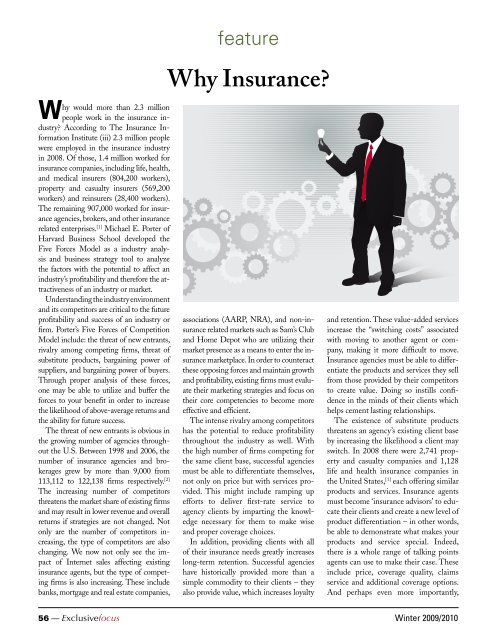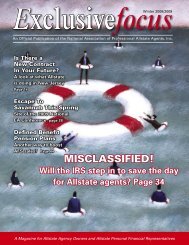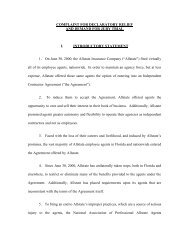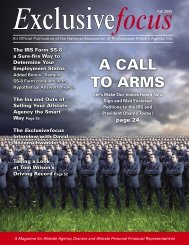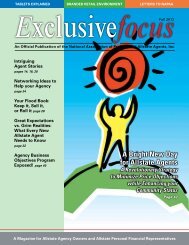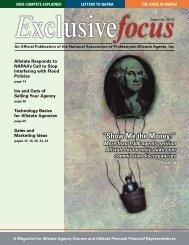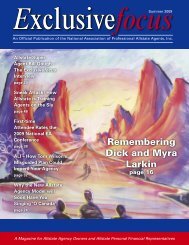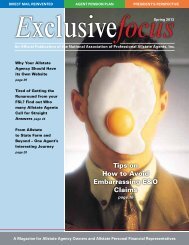Todd McIndoo is a Vice President at Speedy - National Association ...
Todd McIndoo is a Vice President at Speedy - National Association ...
Todd McIndoo is a Vice President at Speedy - National Association ...
- No tags were found...
Create successful ePaper yourself
Turn your PDF publications into a flip-book with our unique Google optimized e-Paper software.
Why would more than 2.3 millionpeople work in the insurance industry?According to The Insurance Inform<strong>at</strong>ionInstitute (iii) 2.3 million peoplewere employed in the insurance industryin 2008. Of those, 1.4 million worked forinsurance companies, including life, health,and medical insurers (804,200 workers),property and casualty insurers (569,200workers) and reinsurers (28,400 workers).The remaining 907,000 worked for insuranceagencies, brokers, and other insurancerel<strong>at</strong>ed enterpr<strong>is</strong>es. [1] Michael E. Porter ofHarvard Business School developed theFive Forces Model as a industry analys<strong>is</strong>and business str<strong>at</strong>egy tool to analyzethe factors with the potential to affect anindustry’s profitability and therefore the <strong>at</strong>tractivenessof an industry or market.Understanding the industry environmentand its competitors are critical to the futureprofitability and success of an industry orfirm. Porter’s Five Forces of CompetitionModel include: the thre<strong>at</strong> of new entrants,rivalry among competing firms, thre<strong>at</strong> ofsubstitute products, bargaining power ofsuppliers, and bargaining power of buyers.Through proper analys<strong>is</strong> of these forces,one may be able to utilize and buffer theforces to your benefit in order to increasethe likelihood of above-average returns andthe ability for future success.The thre<strong>at</strong> of new entrants <strong>is</strong> obvious inthe growing number of agencies throughoutthe U.S. Between 1998 and 2006, thenumber of insurance agencies and brokeragesgrew by more than 9,000 from113,112 to 122,138 firms respectively. [2]The increasing number of competitorsthre<strong>at</strong>ens the market share of ex<strong>is</strong>ting firmsand may result in lower revenue and overallreturns if str<strong>at</strong>egies are not changed. Notonly are the number of competitors increasing,the type of competitors are alsochanging. We now not only see the impactof Internet sales affecting ex<strong>is</strong>tinginsurance agents, but the type of competingfirms <strong>is</strong> also increasing. These includebanks, mortgage and real est<strong>at</strong>e companies,fe<strong>at</strong>ureWhy Insurance?associ<strong>at</strong>ions (AARP, NRA), and non-insurancerel<strong>at</strong>ed markets such as Sam’s Cluband Home Depot who are utilizing theirmarket presence as a means to enter the insurancemarketplace. In order to counteractthese opposing forces and maintain growthand profitability, ex<strong>is</strong>ting firms must evalu<strong>at</strong>etheir marketing str<strong>at</strong>egies and focus ontheir core competencies to become moreeffective and efficient.The intense rivalry among competitorshas the potential to reduce profitabilitythroughout the industry as well. Withthe high number of firms competing forthe same client base, successful agenciesmust be able to differenti<strong>at</strong>e themselves,not only on price but with services provided.Th<strong>is</strong> might include ramping upefforts to deliver first-r<strong>at</strong>e service toagency clients by imparting the knowledgenecessary for them to make w<strong>is</strong>eand proper coverage choices.In addition, providing clients with allof their insurance needs gre<strong>at</strong>ly increaseslong-term retention. Successful agencieshave h<strong>is</strong>torically provided more than asimple commodity to their clients – theyalso provide value, which increases loyaltyand retention. These value-added servicesincrease the “switching costs” associ<strong>at</strong>edwith moving to another agent or company,making it more difficult to move.Insurance agencies must be able to differenti<strong>at</strong>ethe products and services they sellfrom those provided by their competitorsto cre<strong>at</strong>e value. Doing so instills confidencein the minds of their clients whichhelps cement lasting rel<strong>at</strong>ionships.The ex<strong>is</strong>tence of substitute productsthre<strong>at</strong>ens an agency’s ex<strong>is</strong>ting client baseby increasing the likelihood a client mayswitch. In 2008 there were 2,741 propertyand casualty companies and 1,128life and health insurance companies inthe United St<strong>at</strong>es, [1] each offering similarproducts and services. Insurance agentsmust become ‘insurance adv<strong>is</strong>ors’ to educ<strong>at</strong>etheir clients and cre<strong>at</strong>e a new level ofproduct differenti<strong>at</strong>ion – in other words,be able to demonstr<strong>at</strong>e wh<strong>at</strong> makes yourproducts and service special. Indeed,there <strong>is</strong> a whole range of talking pointsagents can use to make their case. Theseinclude price, coverage quality, claimsservice and additional coverage options.And perhaps even more importantly,56 — Exclusivefocus Winter 2009/2010


